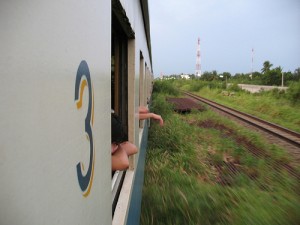Train Travel in Thailand
 Taking the train in Thailand can be an unexpected pleasure. Trains offer excellent value, an environmentally-friendly way to travel, and an opportunity to mingle with locals. Though cheap flights are readily available, the train offers views and interactions unavailable on a quick haul through the sky.
Taking the train in Thailand can be an unexpected pleasure. Trains offer excellent value, an environmentally-friendly way to travel, and an opportunity to mingle with locals. Though cheap flights are readily available, the train offers views and interactions unavailable on a quick haul through the sky.
There are four main lines in Thailand, heading south, north, northeast, and east. In general, the former three are most relevant, as the eastern line is a slow, third-class route to Pattaya that is better served by buses. The Northern line services Chiang Mai and towns in-between Bangkok and Chiang Mai, and the southern line is useful for locations such as Phuket and Ko Samui (even though it doesn’t go directly to these islands).
First and second class cars are clean, air-conditioned, and comfortable, and are a surprising value. Most travelers find second class to be more than adequate, and seats here are significantly cheaper than in first class. Third class seats are generally “hard-seat,” and can be crammed with people. We recommend these for shorter day trips, as you’ll get a colorful slice of local life.
Classes:
First class: If you’re traveling all night and you’ve money to spare, book a private, two-person cabin in first class. You’ll have your own lockable compartment, individually-controlled air-con, and a steward who will take your food orders and deliver your meal to you. Solo travelers will even get paired with a traveler of the same sex!
Second class: This class offers overnight travelers the best value. Two seats face each other on either side of the train, and these seats later fold out into upper and lower berths. Privacy comes in the form of a curtain (bring ear plugs), and most cars are air-conditioned.
Seats in second-class are like those on a bus; two to a row, facing forward, and with the option to recline slightly. These are great for day trips, as they are a comfortable place to watch the scenery go by.
Third class: Often called “hard seat,” third class seats are usually benches facing each other. Faster trains have padded seats, while slower ones are furnished with wooden benches. This class is crazy cheap, and a great way to travel shorter distances. It’s rare to have air-con; instead, the windows will be open to the fragrnt world outside.
Types of trains:
There are many options for the type of train you take, and it can be difficult to decide between trains and then classes. Following is a brief explanation of the types of trains in Thailand.
Ordinary: Local trains that stop at every station. These don’t have first-class cars. Budget food (think street food) is available.
Rapid: These move faster and go farther than the ordinary trains, and have second- and third-class fan options.
Express: Express trains in Thailand have first and second class sleeping berths, and no third class. You won’t find budget food here, though food is definitely available.
Special Express: These run popular routes, and only offer first and second class air-con cars.
Popular destinations:
Long-distance travel via train is an age-old pleasure. If you’re heading north or south out of Bangkok, consider booking a berth on a Thai train rather than taking an all-night bus. The most popular routes (and ones you’ll want to book in advance) are:
Chiang Mai: The terminus of the northern line. To get to Chiang Rai or Pai you’ll need to catch a bus from Chiang Mai.
Vientiane: The link to Vientiane, Laos was only recently completed.
Surat Thani: Surat Thani is a great place to disembark for Phuket, Ko Samui, Ko Phagnan, and other coastal destinations. You can buy combination train/ferry/bus tickets directly to your destination.
Malaysia and Singapore: For as little as $50 USD, you can take a 48-hour train from Bangkok to Kuala Lumpur or Singapore.
Booking and reservations:
Be sure to book well ahead during the holidays, festivals, and the Thai New Year. You can reserve seats at any train station, or pay a travel agent a nominal fee to do it for you. You can also call Bangkok’s Hualampong station at 0-2223-3762.
A couple of websites offer booking services as well; try www.thailandtrainticket.com.
More information:
Getting from Bangkok to Chiang Mai
Getting from Bangkok to Phuket
Getting from Bangkok to Pattaya
Getting from Bangkok to Ko Samui
[Photo credit: garycycles2, Flickr]